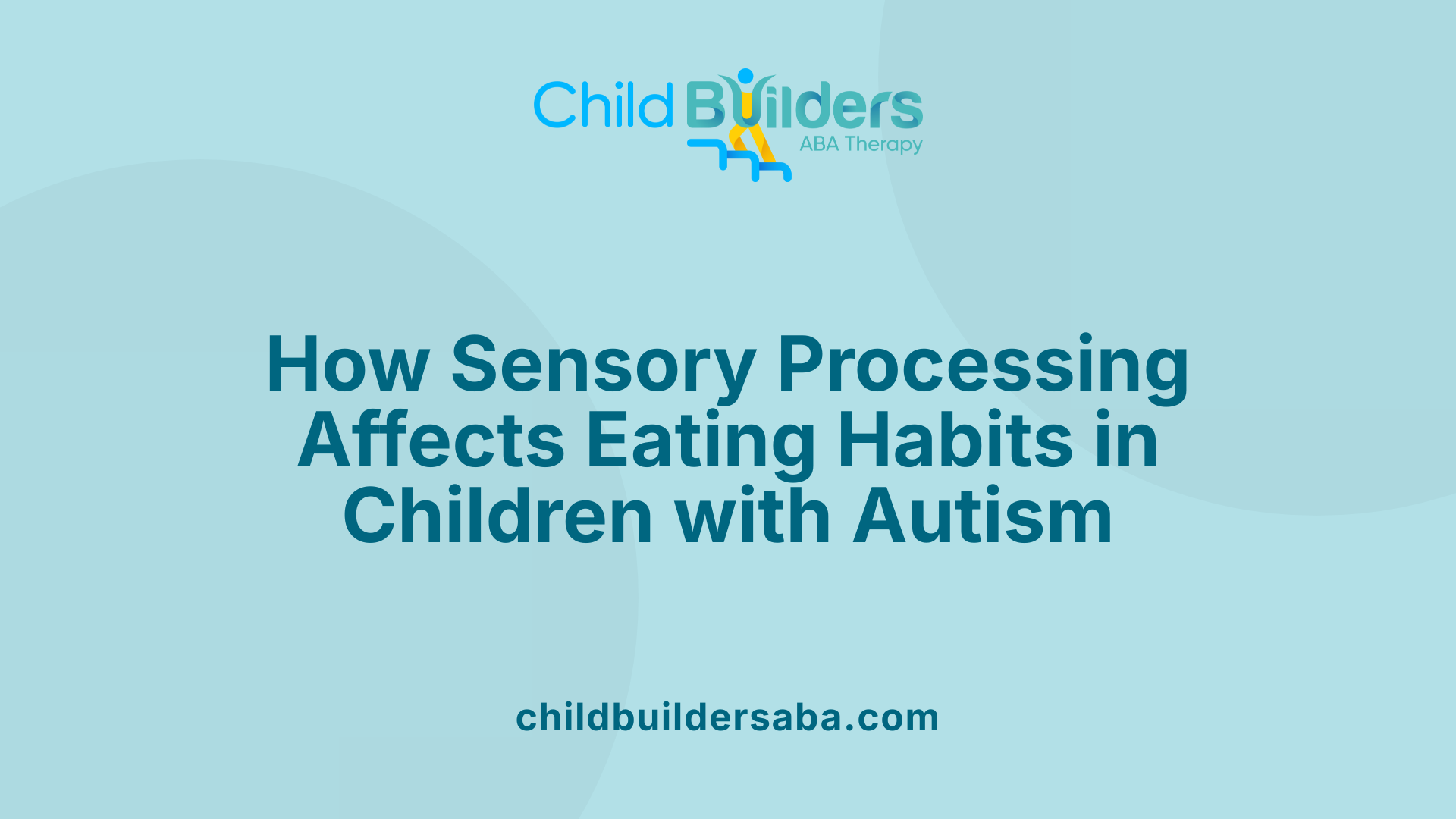Autism And Picky Eating

Navigating the Complexities of Food and Autism
Children on the autism spectrum often face unique challenges with eating, driven by sensory sensitivities and behavioral patterns. Recognizing these patterns and implementing targeted strategies can significantly improve their mealtime experiences and nutritional health.
The Connection Between Autism and Picky Eating

How prevalent is picky eating among children with autism?
Children on the autism spectrum often experience significant challenges with eating, with studies indicating that between 50% and 89% of autistic children demonstrate some form of selective eating or food refusal. These picky eating behaviors can include limited food choices, insistence on sameness, and ritualistic eating routines. For example, many prefer only a few specific foods and frequently avoid entire food groups such as vegetables, fruits, or dairy products.
Research from the SPARK autism study highlights that approximately 16% of children with autism meet the criteria for feeding disorders, and about one in five are at high risk for Avoidant/Restrictive Food Intake Disorder (ARFID). These statistics underscore how common restrictive eating behaviors are within this population.
What are typical eating behaviors and characteristics in children on the autism spectrum?
Children with autism often display unique eating patterns influenced by sensory processing differences. They may have strong aversions to certain smells, textures, or tastes, which limits their acceptance of new or varied foods. Sensory sensitivities are a core feature of autism, affecting preferences for food temperatures, textures, and presentation.
Restricted diets and food selectivity can be reinforced by a desire for predictability, as children tend to avoid foods that don't feel or taste the same every time. Resistance to change and insistence on sameness can extend to food routines, leading to highly ritualistic mealtime behaviors.
These preferences and sensitivities can result in nutrient deficiencies, especially if foods rich in essential nutrients are refused. Many children with autism prefer energy-dense, nutrient-poor foods, which can pose additional health risks.
How does autism impact health and development through eating habits?
The influence of autism on eating habits can have profound implications for health and development. Nutritional deficiencies may arise from selective diets lacking in fruits, vegetables, whole grains, and dairy, affecting growth and overall health. Moreover, picky eating can cause children to feel hungry more often, impacting mood, behavior, and social participation during meals.
Gastrointestinal issues such as constipation, acid reflux, and diarrhea are common in children with autism and can exacerbate eating difficulties, creating a cycle of discomfort that discourages eating.
Beyond physical health, limited diets and mealtime stress can influence emotional development and social interactions. Difficulties with food can restrict participation in family meals and social dining settings, affecting social learning and emotional well-being.
Strategies to improve eating habits include gradual food exposure, involving children in food preparation, using visual schedules, and reinforcing positive behaviors with praise. A multidisciplinary team—comprising dietitians, occupational therapists, and behavior analysts—can design tailored interventions that promote a more varied and nutritious diet, supporting overall development.
| Aspect | Description | Additional Details |
|---|---|---|
| Prevalence of Picky Eating | Between 50%-89% | Significant restriction and ritualistic behaviors |
| Characteristics | Sensory sensitivities, food selectivity | Aversion to textures, smells; insistence on sameness |
| Health Implications | Nutritional deficiencies, GI issues | Risk of anemia, delayed growth, obesity |
| Intervention Approaches | Gradual exposure, positive reinforcement | Use of visual aids, food modification, multidisciplinary strategies |
Understanding and addressing eating behaviors in children with autism require patience and tailored approaches. Recognizing the sensory and behavioral components is essential for improving their mealtime experiences and supporting their health and development.
Sensory Factors Influencing Eating Behaviors in Autism

What are the sensory issues related to food in children with autism?
Sensory challenges are a common aspect of autism that significantly influence eating behaviors. Children on the autism spectrum often experience heightened sensitivities to various sensory inputs related to food. These sensitivities include over- or under-reactivity to tastes, flavors, smells, textures, and visual presentation.
For instance, an autistic child may refuse foods that touch or have a specific texture, such as slimy, gritty, or crunchy foods. They might be particularly sensitive to strong odors, which can cause immediate rejection of certain foods. Predictability and familiarity are crucial, so many children prefer foods that look, smell, and taste the same each time they are served. This selective eating can result in a restricted diet that may lack essential nutrients like calcium, iron, fiber, and vitamins.
Food refusal and selective eating are often driven by these sensory aversions rather than a lack of appetite or dislike for food itself. Some children may develop symptoms resembling eating disorders such as Avoidant/Restrictive Food Intake Disorder (ARFID), where sensory issues are the primary cause. These sensory sensitivities are complex and highly individualized, often affecting nutrition, health, and social participation during mealtimes.
How does sensory hypersensitivity lead to food selectivity?
Sensory hypersensitivity in autistic children causes intense reactions to specific aspects of food, resulting in a very narrow range of accepted foods. For example, a child might avoid foods with certain textures like slimy or crumbly, or reject foods with strong or unfamiliar odors. Additionally, visual aspects such as bright colors, presentation styles, or foods that touch can trigger discomfort or refusal.
This heightened sensitivity stems from differences in sensory processing pathways, making some stimuli overwhelming or unpleasant. As a result, children tend to stick to a limited menu of palatable foods, often preferring only a handful of textures or flavors. This selectivity can lead to nutritional deficiencies and impact growth.
Managing sensory hypersensitivity involves various approaches, including sensory integration therapy to desensitize sensitivities, food modifications that appeal to the child's preferences, and gradual exposure to new foods. Behavioral strategies like positive reinforcement and routine building can also help children expand their diet over time.
The role of sensory processing in food aversions
Sensory processing differences are central to many food aversions seen in children with autism. These aversions are not simply preferences but are rooted in the neurological processing of sensory inputs. When a child's sensory system is overwhelmed or misinterprets certain stimuli, they may experience discomfort or distress, leading to avoidance behaviors.
For example, textures that are too gritty, sticky, or slimy can trigger discomfort, while specific flavors or smells may be intolerable. Visual cues, such as foods with unusual colors or presentation styles, may also evoke rejection.
Understanding the sensory component of food refusal is critical for developing effective interventions. Techniques such as sensory-based feeding therapy, gradual exposure, and the use of visual supports help children become more comfortable with a broader range of foods. This approach not only improves nutrition but also reduces mealtime stress for families.
Effective Strategies and Interventions

What strategies can help autistic children broaden their diets and improve mealtime behaviors?
Helping children on the autism spectrum enjoy a more varied diet involves patience, consistency, and tailored approaches. Establishing predictable routines and scheduled mealtimes provides a sense of stability, which can lessen anxiety around eating.
Gradual food exposure is a central technique. This involves slowly introducing new foods alongside familiar ones, encouraging children to taste, touch, or smell before attempting to eat. Repeated, positive experiences with new foods—starting with textures or flavors similar to preferred items—can foster acceptance over time.
To address sensory sensitivities, modifications may include changing food textures, blending foods into smoothies, or offering foods at different temperatures. These adjustments help make unfamiliar foods more approachable.
Using positive reinforcement enhances motivation. Praising children or rewarding their efforts, such as through preferred activities or small prizes, encourages continued attempts at trying new foods.
In addition to reinforcement, employing visual supports like picture schedules or food choice charts reduces uncertainty and empowers children by giving them control.
Collaboration with healthcare professionals is critical. Occupational therapists, dietitians, and behavior analysts can design individualized intervention plans that consider sensory issues, medical factors, and behavioral challenges.
Overall, patience, a gradual approach, and professional input are vital for expanding children's diets and making mealtime more positive.
Which approaches are supported by research for addressing feeding problems?
Research highlights several evidence-based strategies for managing feeding difficulties in children with autism. Modeling appropriate eating behaviors—such as demonstrating how to chew or taking bites—serves as a behavioral template.
Establishing consistent expectations about mealtime routines and providing clear, simple cues help children understand what is expected. Keeping a food journal allows caregivers to track accepted foods and monitor progress, making it easier to identify patterns or triggers.
Visual supports, including picture schedules or choice boards, help reduce anxiety and increase cooperation during meals. Offering options within a routine—like choosing between two fruits—gives children a sense of control.
Therapies such as sensory integration techniques aim to desensitize or accommodate sensory sensitivities. Behavioral interventions based on applied behavior analysis (ABA) principles have shown positive results in increasing acceptance of new foods.
Working with professionals, including occupational therapists and dietitians, ensures interventions are tailored to each child's needs. Techniques like gradual food introduction, positive reinforcement, and creating a fun, engaging mealtime environment remain cornerstones of effective treatment.
In summary, a combination of modeling, routines, visual supports, and professional support provides a comprehensive approach supported by evidence to improve eating habits among autistic children.
Medical and Dietary Considerations

Why is ruling out gastrointestinal issues essential in managing feeding difficulties?
Gastrointestinal (GI) problems are common among children with autism and can have a profound effect on eating behaviors. Conditions such as acid reflux, constipation, eosinophilic esophagitis, and diarrhea can cause discomfort, pain, or nausea that discourage eating or favor avoidance of certain foods.
When a child experiences ongoing GI issues, they may develop resistance to eating or refuse certain textures and flavors that cause discomfort. This can lead to nutritional deficiencies and exacerbate mealtime challenges.
To effectively manage feeding difficulties, healthcare providers recommend thorough medical evaluations to identify and treat underlying GI conditions. Addressing these issues often results in reduced discomfort, increased appetite, and a greater willingness to try a variety of foods.
A multidisciplinary team—including pediatricians, gastroenterologists, dietitians, and occupational or behavioral therapists—collaborates to develop personalized treatment plans. These plans might involve medication, dietary modifications, or behavioral strategies to improve comfort and expand food choices.
Ruling out medical problems and supporting growth
By ruling out GI problems, caregivers can focus on behavioral and sensory interventions without the confounding factor of physical distress.
Untreated GI issues can lead to persistent picky eating, weight loss, or growth delays. Therefore, regular check-ups and assessments are vital components of managing feeding issues in children with autism.
Importance of a multidisciplinary approach
A comprehensive approach ensures that medical, nutritional, and behavioral aspects are integrated for optimal results. For example, if reflux is diagnosed, medication can be prescribed to reduce symptoms, which often results in better acceptance of new foods.
Occupational therapists and behavior analysts may work together to implement routines, sensory desensitization, and positive reinforcement strategies tailored to each child's needs.
Addressing nutritional gaps and supplementation
Children with restricted diets are prone to deficiencies in essential nutrients like vitamins, minerals, and fiber. Close monitoring through blood tests can identify deficiencies.
In some cases, dietary supplements might be recommended to bridge nutritional gaps, but these should always be used under professional guidance to avoid over-supplementation or adverse effects.
Additional resources and search queries
For further information on gastrointestinal health and its impact on feeding in autism, explore resources using search terms such as "gastrointestinal health and autism feeding issues" to find relevant studies, expert articles, and support organizations.
Supporting Autistic Children in Mealtime Success
Understanding the sensory, behavioral, and medical factors that influence eating in children with autism is vital for developing effective strategies. By combining routines, sensory accommodations, professional support, and patience, caregivers can help autistic children enjoy a healthier, more varied diet. Early intervention, multidisciplinary approaches, and ongoing education empower families to navigate feeding challenges, fostering better health, development, and social engagement.
References
- Autism and Picky Eating - Child Mind Institute
- Autism and food aversions: 7 Ways to help a picky eater
- Food and Autism: Is Your Child a Picky Eater? - University Hospitals
- Avoid Distress At Mealtime: 7 Strategies For Autism And Picky Eating
- Feeding and eating problems in children and adolescents with autism
- Very Picky Eating in Children with Autism
- Don't let dinner turn into a battleground with your picky eater
- Autism and eating - BeyondAutism



.jpg)

































































































